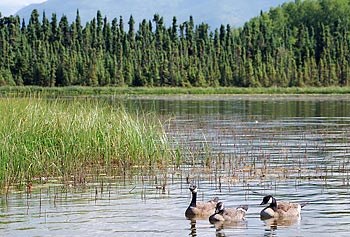National Science Foundation Funds Research

07/10/2013
By Edwin L. Aguirre
A team of researchers from UMass Lowell, Rutgers University and the U.S. Geological Survey recently received a three-year grant worth nearly $830,000 from the National Science Foundation (NSF) to study how wetlands influence mercury contamination in the Arctic regions.
“Mercury has become one of the most insidious pollutants on Earth,” says biology Prof. Mark Hines, who is the acting dean for the College of Sciences and one of the principal investigators for the NSF project. “Although it can be found near industrial sites or mercury mines and can enter the atmosphere from burning of municipal waste, a significant amount is released into the air from burning of coal.”
Hines says the toxic heavy metal can travel thousands of miles, polluting even the most remote areas of the world.
“Mercury that falls back to Earth is extremely bioactive and can be readily converted by bacteria into methylmercury, which is the most toxic form and one that tends to bio-accumulate in the food web, ending up in fish and eventually contaminating wildlife and humans,” he explains. “Methylmercury is most harmful to developing brains and can affect growing fetuses and young children, leading to diminished cognitive ability.”
Studying Alternate Pathways for Producing Methylmercury
Methylmercury is produced by bacteria living in the absence of oxygen, and wetlands are ideal habitats for methylmercury production since decaying plants provide food and the flooded conditions impede the introduction of oxygen. Many years of research have shown that methylmercury-producing bacteria use naturally occurring chemical compounds, such as sulfates or iron oxides, for respiration instead of oxygen.
“However, there are many lakes in remote wetland regions of the Arctic and subarctic that are rich in fish with high levels of methylmercury, but do not seem to contain sufficient levels of sulfates and iron oxides to support methylmercury production,” notes Hines.
Scientists have been puzzled for decades about how these lakes could accumulate so much of the toxin.
Hines and his co-investigators will study alternate ways by which wetland bacteria can produce methylmercury without the need for sulfate or iron. They will test the hypothesis that this methylmercury production occurs through the symbiotic relationship between bacteria that are only able to metabolize by sharing food.
“Our team discovered that duos of bacteria working together were able to produce more methylmercury than individual ones, and in some instances methylmercury was produced only when two species worked together,” says Hines.
The researchers will also explore the idea that the pathway to methylmercury changes as the composition of plants in wetlands changes in response to climate warming, which is exacerbated in northern latitudes.
“If our hypotheses are correct, climate change will greatly affect how methylmercury is created, and this information will help predict rates and effects of methylmercury production in a changing Arctic,” says Hines.
The team’s studies will involve detailed laboratory analyses as well as fieldworks in central Alaska.
“A desired outcome will be to use plant diversity to map how much methylmercury is being produced in the Arctic and how that will change over the decades to come,” says Hines.
Hines is also part of an international team of researchers that was recently awarded a separate three-year grant by the NSF worth more than $1.6 million. This project aims to use new measurement and remote-sensing satellite technologies to greatly fine-tune our knowledge of the production of methane, a very potent greenhouse gas, in northern wetlands and help create a more accurate model of methane emissions on a global scale.
